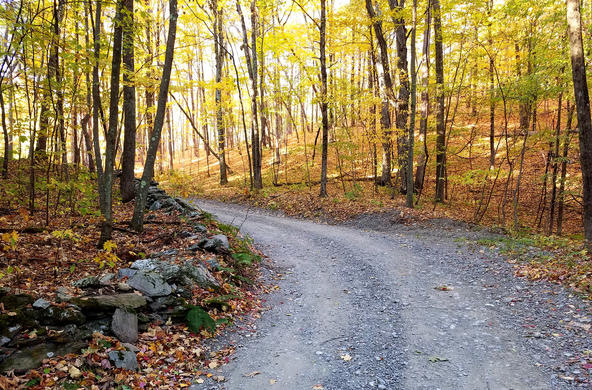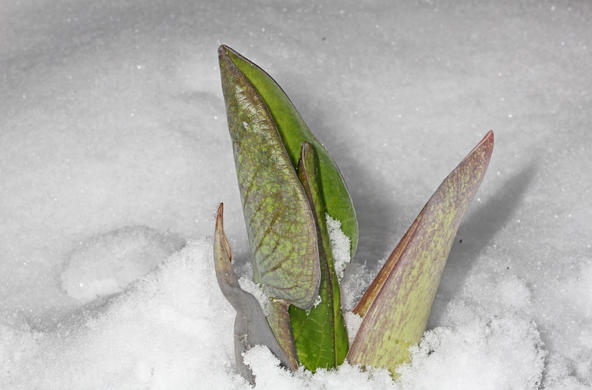To every thing there is a season, and a time to every purpose under the heaven:
A time to be born, and a time to die; a time to plant, and a time to pluck up that which is planted;-Ecclesiastes 3
Spring is in the air. The first Redwing Blackbirds have returned to our local pond, beginning their ritualistic territorial and mating calls. The regular schedule of events in nature is what ecologists call phenology. The diaries of naturalists contain observations of the seasonal activities in nature for centuries. The science of phenology is now advancing with the lengthening record of the Earth's greenness, snowcover and temperature from satellites and other sensors.
For birds that migrate from the tropics, where there is little seasonal change in temperature, the timing of spring migration is determined by the changing length of day. When the days get longer, they know that it is time to go. Species that winter in the warm temperate zone can judge the warming first-hand, and begin their northward migration when the weather seems right. Some even speed their northward journey if conditions are favorable.
Ongoing changes in global climate show up in the historical observations of naturalists. In the Hudson Valley of New York, spring migrant birds are arriving 11.6 days earlier than a century ago. And in the same region, a small pond frog, the Spring Peeper, is now calling earlier. Across Europe, lilac bushes are flowering earlier, and the sensitivity of first flowering to temperature has declined over the past 50 years—what you might expect in a predictably warmer climate. Plants in Washington, D.C. are flowering 2.4 days earlier than 30 years ago. Species are readjusting their behavior to the reality of warmer spring temperature. Nature is validating what we know about climate change from long-term records of temperature.
On one hand, one might argue that these changes reflect the plasticity of nature, as it adapts to climate change. But looking more deeply into the issue, one might see cause for alarm.
The relationships that characterize spring phenology are the products of long-term coevolution. Birds arrive when there are insects to eat, and plants flower when there are bees to pollinate them. Leaf emergence in the temperate forests of North America has advanced about 7 days over the past thirty years, whereas bird arrival has advanced only about half that amount. Unless the timing of various species is precisely coordinated in response to changing climate, the historical relationships between species will be disrupted, to the detriment of their reproductive success and the persistence.
Even in a warmer climate, there are late spring cold snaps and snowstorms that can affect the early arriving individuals that have responded to overall warming climate. Climate scientists tell us that unusual and extreme events are likely to be more frequent in a warmer climate.
We can extend this thinking to the success of crop, nut and fruit plants, whose spring flowering is closely tied to successful pollination. Certainly farmers can replant crops, but once gone, a crop of nuts or fruits is destined to wait until the next season. In both cases, there are significant economic costs to agriculture.
Phenology has moved from the attention of amateur naturalists and into mainstream ecology and global change policy. Let's hope the changes are small.
References
Abu-Asab, M.S., P.M. Peterson, S.C. Shetler, and S.S. Orli. 2001. Earlier plant flowering in spring as a response to global warming in the Washington, D.C. area. Biodiversity and Conservation 10: 597-612.
Calinger, K.M., S. Queenborough, and P.S. Curtis. 2013. Herbarium specimens reveal the footprint of climate change on flowering trends across north-central North America. Ecology Letters 16: 1037-1044.
Franks, S.E. and 7 others. 2018. The sensitivity of breeding songbirds to changes in seasonal timing is linked to population change but cannot be directly attributed to the effects of trophic asynchrony on productivity. Global Change Biology 24: 957-971
Lovett, G. 2013. When do peepers peep? Climate and the date of first calling in the Spring Peeper (Pseudacris crucifer) in southeastern New York State. Northeastern Naturalist 20(2):333-340.
Mahall, B.E. and F.H. Bormann. 1978. A quantitative description of the vegetative phenology of herbs in a northern hardwood forest. Botanical Gazette 139: 467-481.
Melaas, E.K., D. Sulla-Menashe, and M.A. Friedl. 2018. Multi-decadal changes in interannual variation in springtime phenology of North American temperate and boreal deciduous forests. Geophysical Research Letters doi: 10.1002/2017GL076933
Miller-Rushing, A.J., R.B. Primack, D. Primack and S. Mukunda. 2006. Photographs and herbarium specimens as tools to document phenological changes in response to global warming. American Journal of Botany 93: 1667-1674.
Primack, D., C. Imbres, R.B. Primack, A.J. Miller-Rushing, and P. Del Tredici. 2004. Herbarium specimens demonstrate earlier flowering times in response to warming in Boston. American Journal of Botany 91: 1260-1264.
Vitale, J. and W.H. Schlesinger. 2011. Historical analysis of the spring arrival of migratory birds to Dutchess County, New York: A 123-year record. Northeastern Naturalist 18:335-346.
Wang, H., J. Dai, T. Rutishauser, A. Gonsamo, C. Wu and Q. Ge. 2018. Trends and variability in temperature sensitivity of lilac flowering phenology. Journal of Geophysical Research-Biogeosciences doi: 10.1002/2017JG004181.






